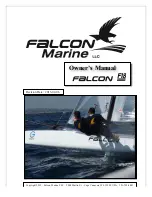
Roller Trailers – Launching
Here are some tips to remember when you are putting your
Chaparral boat in the water while using a roller trailer:
Important: Before launching your boat, make sure the transom
drain plug is installed. If it is not installed, the bilge could fill
with water quickly.
1. Always prepare the boat for launching before you get to the
ramp.
•
Stop in a launching prep area near the ramp that doesn’t
block traffic and remove your tie-downs, tilt up your engine
or drive unit, replace your transom drain plugs, etc.
•
Do not disconnect the wiring harness, winch cable or boat
bow safety chain until you are by the water, ready to launch.
Winch and trailer unit should be locked.
•
You do not need to disconnect the electric trailer brakes
before launching the boat. If you disconnect the electric
trailer brakes, the trailer brakes will not work.
•
Store all loose gear properly.
•
Inventory your safety equipment.
•
Tilt drive unit up to clear the ramp.
2. Have someone at the ramp to give you directions. Slowly back
the trailer down the ramp to the water. If there isn’t a ramp avail-
able, use a solid area of ground to the shore, with a slope if
possible. Avoid wet, soft sand. Always remember to launch your
boat at a right angle to the shore.
3. When the boat’s transom is in several inches of water:
•
Do not put your trailer wheels and brakes in the water if pos-
sible, especially in salt water. Tie a mooring line to the boat
to help you control it in the water.
•
Stop towing vehicle with manual transmission in gear or
automatic transmission in PARK. Remember to turn off
engine and set the parking brake.
•
On average grade ramp, the rollers on your trailer will allow
your boat to gently roll back into the water. Do not remove
the boat bow safety chain or winch lock until the boat and
trailer are located in “launch” position.
•
Once in “launch” position, remove bow safety chain from the
boat. Hold the winch handle securely, reverse the winch lock
and begin unwinding the line. Unwind it slowly and carefully.
•
Move boat down the trailer and into the water.
•
If your boat doesn’t immediately move, try unwinding about
six inches of line, lock your winch and give the boat a push.
Then unlock the winch and try again. Your boat should roll
safely into the water.
•
Tie boat to pier or secure appropriately.
•
Pull your vehicle away and park it.
Important: After each launching, monitor the bilge periodically
to assure against abnormal water intake. Do not leave a new
boat unattended for at least 8 hours after its initial launching. A
5-3
WARNING:
If the winch handle slips out of your hand, let it
spin. DO NOT try to stop it
Summary of Contents for SSX-236
Page 1: ...S S X 2 3 6 2 5 6 2 7 6 2 0 0 9 O W N E R O P E R AT O R M A N U A L...
Page 2: ......
Page 4: ......
Page 17: ...1 7...
Page 18: ......
Page 22: ......
Page 24: ......
Page 40: ...2 16...
Page 52: ...3 12...
Page 80: ...5 16...
Page 98: ......
Page 106: ......
Page 112: ......
Page 113: ...WIRING SCHEMATICS 12 12 1 236 SSX...
Page 114: ...12 2 236 SSX...
Page 115: ...12 3 256 SSX...
Page 116: ...12 4 256 SSX...
Page 117: ...12 5 276 SSX...
Page 118: ...12 6 276 SSX...
Page 119: ......
















































